Is Brazil Good For Tourism? Absolutely! Brazil, with its vibrant culture, stunning landscapes, and diverse experiences, is an incredible destination for tourism. Whether you’re drawn to the bustling city life of Rio de Janeiro, the lush Amazon rainforest, or the beautiful beaches of the coast, Brazil offers something for every traveler. SIXT.VN is here to help you plan your trip, ensuring a seamless and unforgettable experience.
Exploring Brazil means diving into a world of adventure travel, cultural immersion, and breathtaking sightseeing. Let’s delve into why Brazil should be at the top of your travel list.
1. What Makes Brazil a Great Tourist Destination?
Brazil stands out as a top tourist destination due to its unique combination of natural beauty, cultural richness, and vibrant energy. The country offers a diverse range of experiences, from exploring the Amazon rainforest to relaxing on the famous beaches of Rio de Janeiro.
- Natural Beauty: Brazil boasts incredible landscapes, including the Amazon rainforest, Iguazu Falls, and stunning coastlines.
- Cultural Richness: The country’s culture is a vibrant mix of indigenous, African, and European influences, evident in its music, dance, and cuisine.
- Vibrant Energy: From the lively streets of Rio de Janeiro to the festive atmosphere of Carnival, Brazil exudes a unique and infectious energy.
Brazil’s appeal is backed by tourism statistics. According to data from the Brazilian Ministry of Tourism, the country saw a significant increase in international visitors in recent years, highlighting its growing popularity as a tourist destination.
2. What Are the Top Tourist Attractions in Brazil?
Brazil is home to numerous iconic attractions that draw visitors from around the globe. These destinations showcase the country’s diverse landscapes, rich history, and vibrant culture.
| Attraction | Description | Why Visit |
|---|---|---|
| Christ the Redeemer | An iconic statue of Jesus Christ overlooking Rio de Janeiro. | Offers breathtaking panoramic views of the city and is a symbol of Brazilian Christianity. |
| Sugarloaf Mountain | A peak situated in Rio de Janeiro, offering stunning views of the city and Guanabara Bay. | Provides incredible photo opportunities and a unique perspective of Rio’s landscape. |
| Iguazu Falls | A spectacular waterfall system on the border of Brazil and Argentina. | Showcases the immense power and beauty of nature, with numerous viewpoints and trails for exploration. |
| Amazon Rainforest | The world’s largest rainforest, home to an incredible array of plant and animal species. | Offers unique opportunities for wildlife spotting, eco-tourism, and experiencing the biodiversity of the Amazon basin. |
| Copacabana Beach | A famous beach in Rio de Janeiro, known for its vibrant atmosphere and beautiful coastline. | Perfect for relaxing, swimming, sunbathing, and enjoying the lively beach culture. |
| Carnival in Rio de Janeiro | The world’s largest carnival, featuring vibrant parades, music, and street parties. | Provides an unforgettable cultural experience, showcasing Brazilian music, dance, and festive spirit. |
| Historic Center of Salvador | A UNESCO World Heritage site, showcasing colonial architecture and Afro-Brazilian culture. | Offers a glimpse into Brazil’s history and cultural heritage, with colorful buildings, museums, and cultural events. |
| Pantanal | The world’s largest tropical wetland, known for its diverse wildlife. | Ideal for wildlife enthusiasts, offering opportunities to spot jaguars, capybaras, and a variety of bird species. |
| Fernando de Noronha | A volcanic archipelago with pristine beaches and crystal-clear waters. | Perfect for diving, snorkeling, and enjoying the untouched natural beauty of the islands. |
| Ouro Preto | A historic city with well-preserved colonial architecture. | Provides a fascinating look into Brazil’s gold rush era, with beautiful churches, museums, and cobblestone streets. |
3. What Are the Best Times to Visit Brazil?
The best time to visit Brazil depends on the region and your preferences. Generally, the shoulder seasons (April-May and September-October) offer pleasant weather and fewer crowds.
- Rio de Janeiro: April to May and September to October for milder temperatures and fewer tourists.
- Amazon: June to September for the dry season, making it easier to explore the rainforest.
- Iguazu Falls: August to November for pleasant weather and good visibility.
- Carnival: February or March, but be prepared for large crowds and higher prices.
According to weather data, these months typically offer the most favorable conditions for tourism in Brazil, allowing visitors to fully enjoy the country’s attractions.
4. How Safe is Brazil for Tourists?
While Brazil is a popular tourist destination, it’s essential to be aware of safety concerns. Like any large country, Brazil has areas with higher crime rates, particularly in urban centers.
- General Safety Tips:
- Avoid displaying expensive jewelry or gadgets.
- Be aware of your surroundings, especially in crowded areas.
- Use reputable transportation services, such as SIXT.VN, for airport transfers and city tours.
- Stick to well-lit and populated areas, especially at night.
- Learn some basic Portuguese phrases to communicate more effectively.
- Safety in Major Cities:
- Rio de Janeiro: Exercise caution in favelas (slums) and avoid walking alone at night.
- São Paulo: Be vigilant in crowded areas and use licensed taxis or ride-sharing services.
- Salvador: Stick to the historic center and avoid venturing into less touristy areas without a guide.
According to travel advisories, tourists should take precautions and stay informed about current safety conditions. Using reliable services like SIXT.VN can enhance your safety and overall travel experience.
5. What Are the Best Ways to Travel Around Brazil?
Traveling around Brazil requires careful planning due to its vast size. Several transportation options are available, each with its advantages and disadvantages.
| Transportation Mode | Description | Pros | Cons |
|---|---|---|---|
| Flights | Domestic flights connect major cities and regions. | Fast and efficient for covering long distances. | Can be expensive, especially during peak season. Delays and cancellations are possible. |
| Buses | Extensive bus network connects most cities and towns. | Affordable and comfortable for long-distance travel. | Travel times can be lengthy. Safety concerns in some areas. |
| Rental Cars | Renting a car offers flexibility to explore at your own pace. | Freedom to explore remote areas and customize your itinerary. | Road conditions can vary. Traffic in major cities can be challenging. |
| Ride-Sharing Services | Apps like Uber and 99 are available in major cities. | Convenient and relatively affordable for city travel. | Availability may be limited in some areas. Safety concerns in certain neighborhoods. |
| Guided Tours | Organized tours provide structured itineraries and local expertise. | Hassle-free travel with pre-arranged transportation and activities. Local guides offer insights. | Less flexibility compared to independent travel. Can be more expensive than self-guided options. |
| SIXT.VN Services | SIXT.VN offers reliable airport transfers, city tours, and private transportation. | Safe, convenient, and personalized transportation solutions. Professional and English-speaking drivers. | May be more expensive than public transportation. Requires advance booking. |
SIXT.VN’s services ensure a smooth and safe travel experience, allowing you to focus on enjoying your trip.
6. What is the Cost of Traveling in Brazil?
The cost of traveling in Brazil can vary widely depending on your travel style and destination. Here’s a general breakdown of expenses:
| Expense Category | Description | Average Cost (per day) |
|---|---|---|
| Accommodation | Hostels, budget hotels, mid-range hotels, luxury resorts. | $20 – $200+ |
| Transportation | Domestic flights, buses, rental cars, taxis, ride-sharing services. | $15 – $100+ |
| Food | Street food, local restaurants, tourist restaurants, fine dining. | $10 – $50+ |
| Activities | Entrance fees, tours, excursions, nightlife. | $15 – $100+ |
| Miscellaneous | Souvenirs, tips, personal expenses. | $10 – $30+ |
According to budget travel guides, backpackers can travel on a budget of $40-$70 per day, while mid-range travelers should expect to spend $100-$250 per day. Luxury travel can easily exceed $300 per day.
7. What Are Some Essential Portuguese Phrases for Tourists?
Knowing some basic Portuguese phrases can significantly enhance your travel experience in Brazil.
| Phrase | Translation | Use |
|---|---|---|
| Olá | Hello | General greeting |
| Bom dia | Good morning | Greeting in the morning |
| Boa tarde | Good afternoon/evening | Greeting in the afternoon or evening |
| Boa noite | Good night | Greeting at night or when saying goodbye |
| Por favor | Please | Polite request |
| Obrigado (masculine) / Obrigada (feminine) | Thank you | Expressing gratitude |
| De nada | You’re welcome | Responding to thank you |
| Com licença | Excuse me | Getting someone’s attention or asking to pass by |
| Quanto custa? | How much does it cost? | Asking the price |
| Onde fica…? | Where is…? | Asking for directions |
| Eu não falo português | I don’t speak Portuguese | Indicating you don’t speak the language |
| Você fala inglês? | Do you speak English? | Asking if someone speaks English |
| Ajuda | Help | Requesting assistance |
| Tudo bem? | How are you? / Is everything okay? | Checking on someone or asking how they are doing |
| Eu quero… | I want… | Ordering food or requesting something |
Learning these phrases can help you navigate daily interactions and show respect for the local culture.
8. What Are the Cultural Norms and Customs in Brazil?
Understanding Brazilian cultural norms and customs can help you avoid misunderstandings and show respect for the local culture.
- Greetings: Brazilians are generally warm and affectionate. Greetings often involve a handshake, a hug, or a kiss on the cheek, depending on the relationship.
- Punctuality: Brazilians tend to be more relaxed about time. It’s common for people to arrive late to appointments or social gatherings.
- Dining Etiquette: Table manners are generally informal. It’s polite to try a bit of everything and compliment the food.
- Dress Code: Dress codes vary depending on the occasion. In general, Brazilians dress casually, especially in beach areas.
- Gift Giving: Small gifts are appreciated when visiting someone’s home. Common gifts include flowers, chocolates, or wine.
- Personal Space: Brazilians tend to stand closer to each other during conversations. Maintaining eye contact is also important.
- Tipping: Tipping is customary in restaurants and for services. A 10% service charge is often included in the bill.
- Carnival: Carnival is a significant cultural event in Brazil. It’s a time of celebration, music, and dance.
Respecting these customs can help you build positive relationships and enhance your travel experience in Brazil.
9. What Are Some Popular Brazilian Foods to Try?
Brazilian cuisine is a delicious blend of indigenous, African, and European influences. Here are some must-try dishes:
| Dish | Description | Ingredients |
|---|---|---|
| Feijoada | A hearty black bean stew, considered Brazil’s national dish. | Black beans, various cuts of pork and beef, sausages, and spices. |
| Churrasco | Brazilian barbecue, featuring a variety of grilled meats. | Beef, pork, chicken, sausages, and other meats, seasoned with salt and spices. |
| Moqueca | A flavorful seafood stew, typically made with fish or shrimp. | Fish or shrimp, coconut milk, tomatoes, onions, peppers, cilantro, and dendê oil (palm oil). |
| Pão de Queijo | Cheesy bread rolls, a popular snack and breakfast item. | Tapioca flour, cheese (usually Minas cheese), milk, eggs, and oil. |
| Brigadeiro | A classic Brazilian chocolate fudge ball. | Sweetened condensed milk, cocoa powder, butter, and chocolate sprinkles. |
| Coxinha | A teardrop-shaped chicken fritter, a popular street food. | Shredded chicken, creamy dough (made with wheat flour and chicken broth), breadcrumbs, and spices. |
| Acarajé | A deep-fried fritter made from black-eyed peas, a staple of Afro-Brazilian cuisine. | Black-eyed peas, onions, salt, and dendê oil (palm oil). Typically served with vatapá (shrimp and coconut milk stew) and caruru (okra stew). |
| Caipirinha | Brazil’s national cocktail, made with cachaça (sugarcane spirit), lime, and sugar. | Cachaça, lime, sugar, and ice. |
| Tapioca | A gluten-free crepe made from tapioca starch, can be filled with sweet or savory ingredients. | Tapioca starch, various fillings such as cheese, coconut, chocolate, or meats. |
| Guaraná | A popular Brazilian soft drink made from the guaraná fruit, known for its natural caffeine content. | Carbonated water, guaraná extract, sugar, and citric acid. |
Sampling these dishes will give you a taste of Brazil’s diverse culinary heritage.
10. What Are Some Lesser-Known Destinations in Brazil Worth Visiting?
Beyond the famous tourist spots, Brazil offers numerous hidden gems that are worth exploring.
| Destination | Description | Why Visit |
|---|---|---|
| Chapada Diamantina | A national park in Bahia, known for its stunning landscapes, waterfalls, and hiking trails. | Perfect for outdoor enthusiasts, offering breathtaking views, challenging hikes, and opportunities to connect with nature. |
| Lençóis Maranhenses | A unique landscape of white sand dunes and clear lagoons in Maranhão. | Provides a surreal and unforgettable experience, with opportunities for swimming, hiking, and photography. |
| Bonito | A town in Mato Grosso do Sul, known for its crystal-clear rivers and eco-tourism activities. | Ideal for snorkeling, diving, and exploring the region’s diverse aquatic ecosystems. |
| Jericoacoara | A remote beach village in Ceará, known for its stunning sunsets and laid-back atmosphere. | Perfect for relaxing, kite surfing, and enjoying the natural beauty of the coastline. |
| Ilha Grande | An island off the coast of Rio de Janeiro, offering pristine beaches, hiking trails, and lush rainforest. | Provides a peaceful escape from the city, with opportunities for swimming, snorkeling, and exploring the island’s natural beauty. |
| Ouro Preto | A historic city in Minas Gerais, known for its well-preserved colonial architecture. | Offers a glimpse into Brazil’s gold rush era, with beautiful churches, museums, and cobblestone streets. |
| Paraty | A charming coastal town in Rio de Janeiro, known for its colonial architecture and nearby islands. | Perfect for exploring the town’s historic center, kayaking in the bay, and enjoying the region’s natural beauty. |
| Tiradentes | A historic town in Minas Gerais, known for its colonial architecture and cultural events. | Provides a charming and authentic Brazilian experience, with opportunities to explore the town’s historic center and attend festivals. |
| Alter do Chão | A village on the Tapajós River in Pará, known for its beautiful beaches and Amazonian culture. | Offers a unique Amazonian experience, with opportunities for swimming, exploring the river, and learning about local culture. |
| Serra da Capivara | A national park in Piauí, known for its prehistoric rock paintings. | Provides a fascinating look into Brazil’s ancient history, with opportunities to explore the park’s archaeological sites. |
Exploring these lesser-known destinations will give you a deeper appreciation for Brazil’s diversity and beauty.
Conclusion: Is Brazil Your Next Travel Destination?
So, is Brazil good for tourism? Absolutely. With its stunning landscapes, rich culture, and vibrant energy, Brazil offers an unforgettable travel experience. Whether you’re exploring the Amazon rainforest, relaxing on the beaches of Rio de Janeiro, or immersing yourself in the local culture, Brazil has something for everyone.
Ready to plan your dream trip to Brazil? SIXT.VN is here to help with reliable airport transfers, city tours, and personalized transportation solutions. Contact us today to start planning your Brazilian adventure and discover why Brazil is a top destination for tourism.
Contact Information:
- Address: 260 Cau Giay, Hanoi, Vietnam
- Hotline/Whatsapp: +84 986 244 358
- Website: SIXT.VN
Enjoy your trip to Brazil!
FAQ About Tourism in Brazil
Q1: Is Brazil safe for solo female travelers?
While Brazil is generally safe, solo female travelers should take extra precautions. Avoid walking alone at night, especially in less touristy areas. Use reputable transportation services and be aware of your surroundings.
Q2: What vaccinations do I need for Brazil?
It’s recommended to consult with your doctor or a travel clinic before visiting Brazil. Common vaccinations include yellow fever, hepatitis A, and typhoid. Depending on your itinerary, other vaccinations may be advised.
Q3: What is the currency in Brazil?
The currency in Brazil is the Brazilian Real (BRL). Credit cards are widely accepted in major cities, but it’s a good idea to have some cash on hand for smaller establishments and remote areas.
Q4: Do I need a visa to visit Brazil?
Visa requirements vary depending on your nationality. Citizens of many countries, including the United States, Canada, and the European Union, can enter Brazil for tourism purposes without a visa for up to 90 days.
Q5: What is the best way to stay connected in Brazil?
You can purchase a local SIM card or use international roaming from your home country. Wi-Fi is available in many hotels, restaurants, and cafes, but it may not be reliable in all areas.
Q6: What should I pack for a trip to Brazil?
Pack light, comfortable clothing, swimwear, sunscreen, insect repellent, and a hat. If you plan to hike or explore the rainforest, bring sturdy shoes and rain gear.
Q7: What are some etiquette tips for visiting Brazil?
Brazilians are generally warm and friendly. Greet people with a handshake or a kiss on the cheek (depending on the region and relationship). Be punctual, but don’t be surprised if others are late. Dress modestly when visiting religious sites.
Q8: What are some popular souvenirs to buy in Brazil?
Popular souvenirs include cachaça (sugarcane spirit), coffee, Havaianas sandals, and handicrafts made from local materials.
Q9: Are there any cultural events or festivals I should be aware of?
Carnival in Rio de Janeiro is the most famous festival in Brazil, but there are many other cultural events throughout the year, such as the Festa Junina (June Festival) and the Parintins Folklore Festival.
Q10: How can SIXT.VN help with my trip to Brazil?
SIXT.VN offers reliable airport transfers, city tours, and private transportation services in Brazil. Our professional and English-speaking drivers can ensure a safe, convenient, and personalized travel experience.
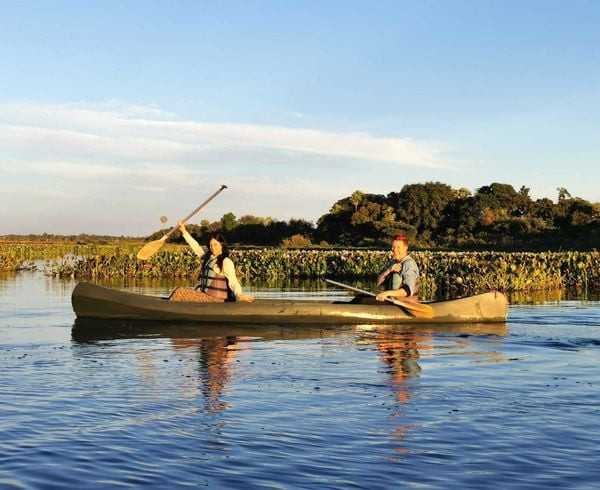 Kayaking in the Pantanal, Brazil.
Kayaking in the Pantanal, Brazil.
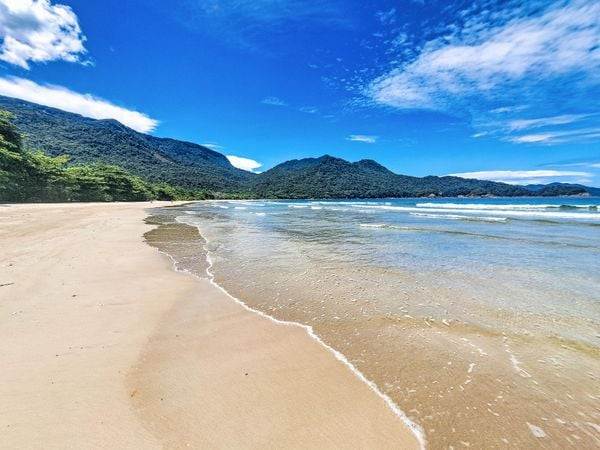 Dois Rios Beach on Ilha Grande, Brazil. Photo: Shutterstock.
Dois Rios Beach on Ilha Grande, Brazil. Photo: Shutterstock.
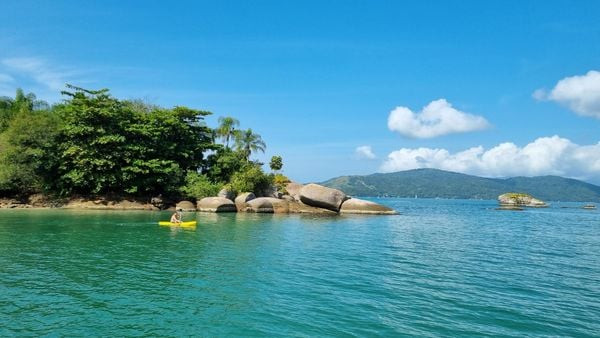 Kayaking in Paraty Bay, Brazil
Kayaking in Paraty Bay, Brazil
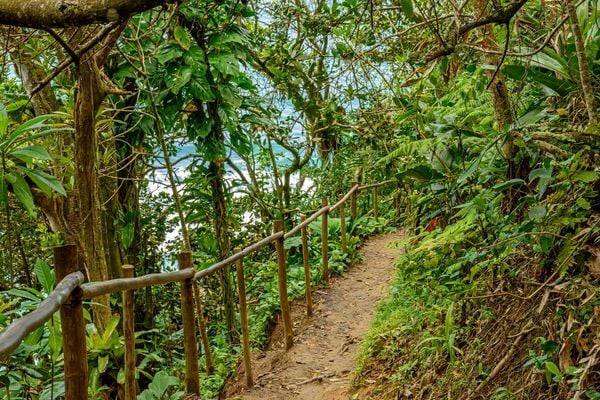 A delightfully uncrowded trail in Ilha Grande. Photo: Getty.
A delightfully uncrowded trail in Ilha Grande. Photo: Getty.
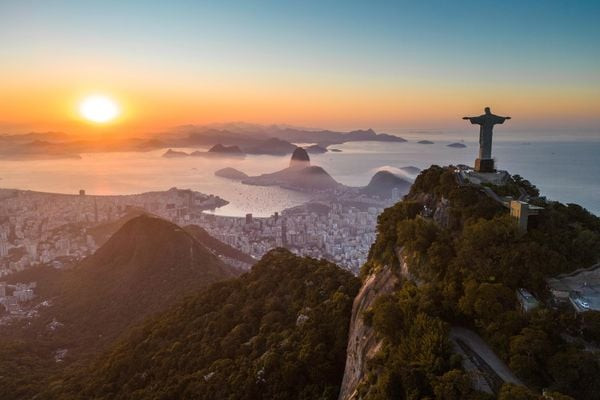 Sunrise over the city of Rio de Janeiro. Photo: Shutterstock.
Sunrise over the city of Rio de Janeiro. Photo: Shutterstock.
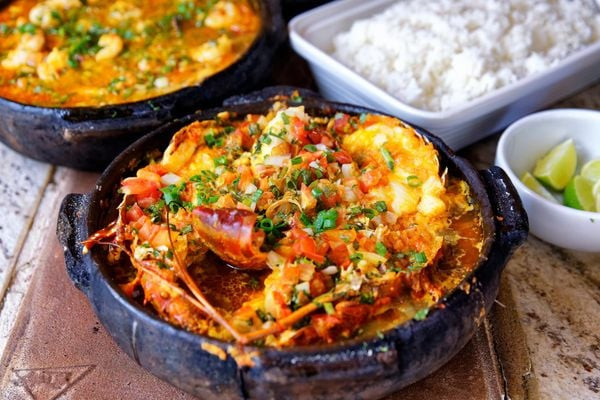 Moqueca, a
Moqueca, a
 Making friends at the Grande Rio Samba School. Photo: Marta Marinelli.
Making friends at the Grande Rio Samba School. Photo: Marta Marinelli.
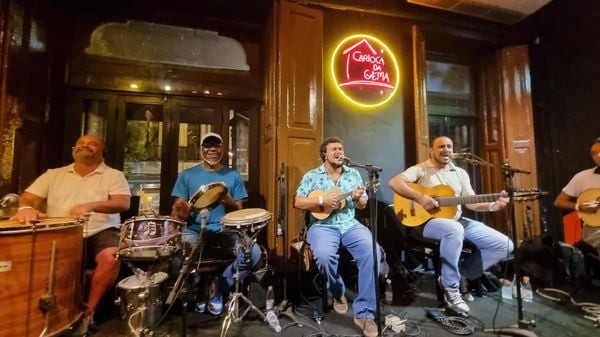 Musicians playing samba in Rio de Janeiro. Photo: Marta Marinelli.
Musicians playing samba in Rio de Janeiro. Photo: Marta Marinelli.



